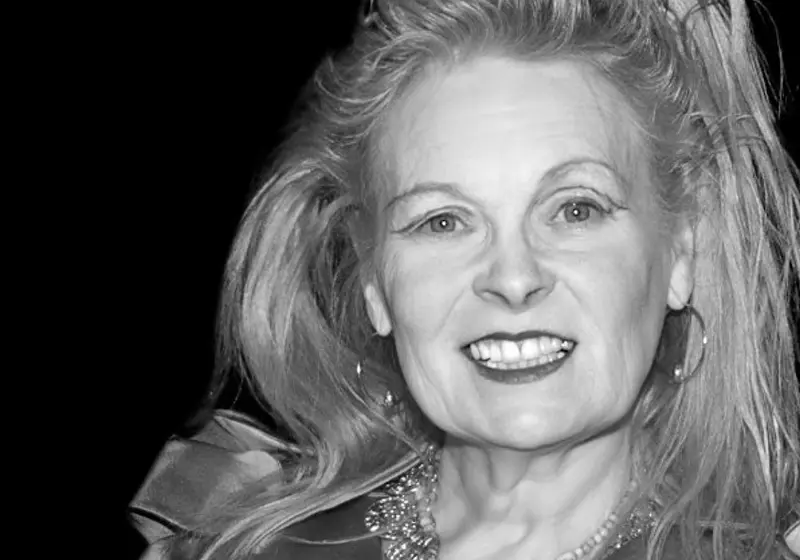Perhaps you’ve seen the staple pearl necklaces with a crystal-studded saturn attached. In school? On social media?
Celebrities wearing them? If you were to search for a “Saturn necklace,” you’d see a particular name show up: Vivienne Westwood.

Image credit: Wikimedia Commons
It is no secret that Vivienne Westwood has always incorporated a form of political agenda, rebellion, and punk into her style and fashion, hence her nickname, “the Queen of Punk.” Since the emergence of her style, she has used several elements that were particularly unusual and noticeable in the fashion industry at the time.
Various components such as provocative statements and slogans, safety pins, ripped clothes, and political graphics were incorporated into her clothing, leading to her “punk” fashion sense, which would later become one of the most iconic in the history of fashion. Innovative hairstyles, in addition to the visionary makeup in her fashion shoots, would be of the typical punk aesthetic of the time. She also had a massive impact on Japanese fashion, gaining popularity in the Japanese manga series, Nana, in addition to her profound love of Japan's revolutionary fashion style.
Westwood was born as Vivienne Isabel Swire on April 8, 1941, in the English town of Glossop. Growing up in a family with no relation to fashion whatsoever, it wasn't until much later that she got her start in fashion. Westwood worked as a primary school teacher until 1962, when she met her first husband, Derek Westwood. During her years of teaching, she would make dresses and jewelry on the side with skills she had taught herself, never attending fashion school.
The year 1965 arrived rapidly and would soon be a key year in Westwood's history. That same year Westwood divorced, she met her future long-time partner: Malcolm McLaren. She would design and produce Teddy Boy clothes for Malcolm, and in 1961, they opened a small boutique called “Let it Rock” at 430 Kings Road in London.
Their partnership rapidly came to be the fashion center of the punk movement. Between the years 1971 and 1976, they had changed the name of their store multiple times before they claimed the name “World's End”, the name that the store still possesses today.
Image credit: Wikimedia Commons
In 1981, the pair's first collaboration took the runway. By the name of “Pirate”, the Fall-Winter 1981-1982 collection was inspired by McLaren's profound interest in the 1980's movie “The Island”, while Westwood's attention was drawn to 18th-century dandies, combined with the Indigenous Americans.
Those three focal points of their interests were key in their first collection, inspiring a long line of fashion history that still has an impact now, over forty years later.

Image credit: Wikimedia Commons
Westwood's name in fashion, from then on, only began to grow. Three years after the initial release of her first collection with McLaren, Westwood was invited to showcase her Spring-Summer 1984 collection “Hypnos” in Tokyo, at the “Hanae Mori's ‘Best of Five’” global fashion awards. In addition to some of her largest accomplishments in the 80s, it was also the time one of her most famous pieces was born: The Mini-Crini and the Rocking Horse shoes, both shown in the 1985 Spring-Summer catwalk.
From the years 1988 to 1993, Westwood entered a new era. During this time, punk culture started to go mainstream, as Westwood's style shifted to the so-called “Tatler” girls to mock and parody the upper class. This era of hers was labeled the “Britain Must Go Pagan” period by Westwood herself, combining elements from classic British tailoring with the fine arts of the ancient Greeks.
In 1990 and 1991, Westwood received the award for “Fashion Designer of the Year" from the British Fashion Council. 1992 was another big year for her, as Queen Elizabeth herself awarded Westwood with the O.B.E (Most Excellent Order of the British Empire). That same year, Westwood introduced wedding gowns to her label for the first time. A year later, Westwood remarried to her assistant Andreas Kronthaler.

Image credit: Wikimedia Commons
Westwood released her first fragrances during this time, her debut named “Boudoir” in 1998, the Vivienne Westwood MAN in 1996, and the Red Label in 1999.
From 1993 to 1999, the Anglomania era was infamously named. Westwood's style significantly shifted to English and French influences, with intricate British tailoring and abstract French shapes and proportions. The well-known McAndreas tartan was presented for the first time in Westwood's Fall/Winter 1993/94 collection, named after her husband. It was woven by Lochcarron of Scotland and is now in the Scottish Register of Tartans.

Image credit: Wikimedia Commons
The 2000s to the present time were a pivotal moment in Westwood's career, as her focus shifted to her growing passion for climate activism. “Climate change, not fashion, is now my priority,” was what she told The Guardian in 2014. Spring-Summer 2013 “Climate Revolution” was connected to a climate foundation she founded in 2012, where she worked with other charities. Westwood had also staged a presentation of her models holding signed that read slogans such as “Climate Revolution”, “Austerity Is A Crime”, and “Politicians Are Criminals”.

Image credit: Wikimedia Commons
Westwood's passion for climate activism only heightened, leading her to make the decision to go digital with all her fashion shows, resulting in her last in-person show being the Autumn-Winter 2019 show at London Fashion Week.
Her political agenda influenced what is considered her most political collection, the Spring 2006 show “AR”, which stands for “active resistance to propaganda”.
Unfortunately, Westwood passed in 2022. Many notable designers and celebrities attended her tribute show, such as Stella McCartney and Marc Jacobs. Referred to as the “queen of punk,” Westwood forever remains a pioneer in punk fashion and revolutionary styles.
Her contribution to the world of fashion has influenced countless shows, pieces, and designers. Many of her pieces are still worn today, and the iconic pearl-and-Saturn necklace remains a classic piece in society's staple fashion items.








